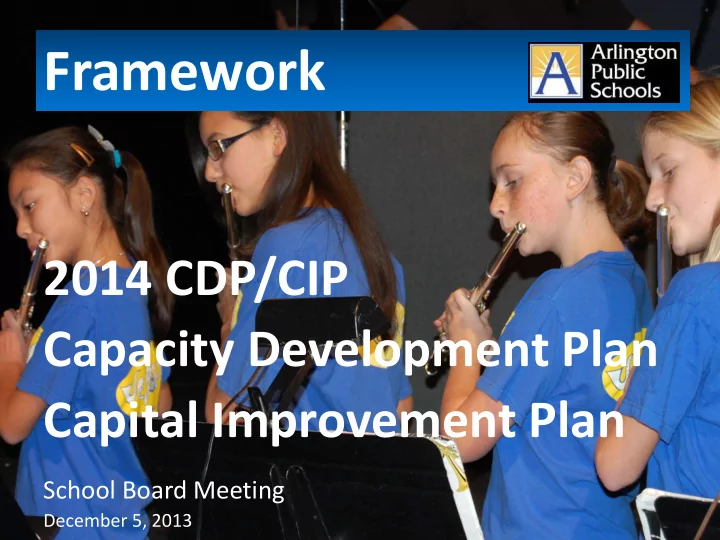

Framework 2014 CDP/CIP Capacity Development Plan Capital Improvement Plan School Board Meeting 1 December 5, 2013
Agenda 1. Introduction 2. Enrollment Growth 3. Debt Capacity 4. Finance 5. School Board Direction 6. Framework Components 7. Capacity Development/Capacity Planning Process 8. Capital Projects 9. Minor Capital/Major Maintenance (MC/MM) 10. Non-Capital Strategies 11. Action Plan for Relocatable Classrooms 12. Strategies for Most Immediate Capacity Needs 2
1.0 Introduction • The CDP/CIP ensures that APS will continue to: – Provide optimal learning environments (Goal 4) – Meet the needs of the whole child (Goal 5) – Address growth in enrollment • Slated for adoption in June 2014 3
2.0 Enrollment Growth 2.1 1,772 more elementary school students in 2018, plus another 497 students by 2023 2.2 1,328 more middle school students in 2018, plus another 630 students by 2023 2.3 1,007 more high school students in 2018, plus another 1,972 students by 2023 2.4 Uneven distribution of growth through the various school attendance zones 4
3.0 Debt Capacity 3.1 Achieve the greatest return on investment by addressing the most critical needs for new seats within available debt capacity 3.2 Create new seats by means of both capital construction expenditure under the CIP and non-capital strategies funded from the operations budget under the CDP 3.3 Recognize the value of relocatable classrooms as both vital to capacity development and a hedge against constructing too many seats should enrollment decline in the future 5
4.0 Finance 4.1 Provide an analysis of APS debt capacity under various funding scenarios to determine the ability of APS to fund future construction projects and the timelines for doing so 4.2 Assess potential for capital funding from alternative sources such as public/private and higher education partnerships 4.3 Optimize the value of existing assets 4.4 Ensure continuation of the capital reserve 6
5.0 School Board Direction 5.1 Do not construct a new comprehensive high school comparable to the three existing high schools 5.2 Consider non-boundary options to balance capacity among the three comprehensive high schools 5.3 Reevaluate the second new elementary school proposed in the 2012 CIP 7
6.0 Framework Components 6.1 APS Strategic Plan for 2011-2017 6.2 Alignment with Arlington County Government’s planning for SMART GROWTH 6.3 Agreement between Arlington County Government and APS on joint-use of facilities 6.4 APS Progressive Capacity Planning Model developed in 2010 8
Framework Components 6.5 More Seats for More Students community engagement process created during the 2012 CIP planning process 6.6 Capital projects included in the 2012 CIP: Ashlawn, New ES#1, McKinley, ATS and New ES#2 6.7 Priorities established during the 2013 Community Survey on Boundaries for seven elementary schools in North Arlington 9
7.0 CDP / CIP Process 7.1 Capital projects to be funded within available debt capacity 7.2 Minor Capital/Major Maintenance Projects to be funded within available debt capacity 7.3 Non-capital strategies to be funded from operations budget 7.4 Action plan for relocatable classrooms 7.5 Strategies to address immediate needs at schools with most critical capacity needs 10
8.0 Capital Projects 8.1 Address most critical capacity shortfalls 8.2 Continue to address growth in elementary school enrollment 8.3 Reevaluate construction of second new elementary school 8.4 Develop options and locations to address middle school enrollment growth 8.5 Develop options and locations to address high school enrollment growth 11
Capital Projects 8.6 Evaluate relocation and/or expansion of existing programs and facilities necessitating new construction to address middle and/or high school enrollment growth 8.7 Develop options for growth at Arlington Career Center 8.8 Evaluate potential of existing APS sites for new construction to address middle and/or high school enrollment growth 12
Capital Projects 8.9 Develop criteria that the School Board will use to evaluate possible locations for new construction 8.10 Evaluate relocation of School Board and administrative offices from Education Center to leased space 8.11 Align with Arlington County Government’s planning for SMART GROWTH 13
9.0 Minor Capital/Major Maintenance 9.1 Identify major maintenance investment needs for APS facilities, such as repair and/or replacement of HVAC, roofing, and building envelope systems 9.2 Identify opportunities to supplement the MC/MM fund 9.3 Evaluate performance contracting and funding methods to advance goals for energy and environmental performance 14
10.0 Non-Capital Strategies 10.1 Increasing class size 10.2 Adjusting schedules and utilization factors to increase number of periods during school day 10.3 Creating year-round schools 10.4 Expanding virtual class offerings and developing twenty-four/seven learning 10.5 Relocating programs, creating school-within- school programs and changing admissions / transfer policies to address uneven enrollment growth 15
Non-Capital Strategies 10.6 Teaming among elementary schools to address uneven enrollment growth in certain areas of County 10.7 Improving utilization of existing middle and high schools as has already been implemented and will continue to be implemented at elementary schools 10.8 Expanding partnerships with higher education institutions 10.9 Leasing/sharing available space in adjacent facilities 16
11.0 Action Plan for Relocatables 11.1 Evaluate/verify need for relocatables at each school 11.2 Identify potential locations for future installation of relocatables 11.3 Comply with new storm water regulations 11.4 Comply with parking ordinance 11.5 Balance reduction of site amenities 11.6 Integrate relocatables better with their sites 11.7 Enhance relocatables and the spaces around them as learning environments 17
Most Immediate Capacity Needs 11.8 APS will analyze enrollment projections to identify and address the schools with the most immediate capacity needs in a tiered approach by fiscal year 18
Thank You ??? 19
Recommend
More recommend